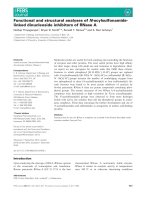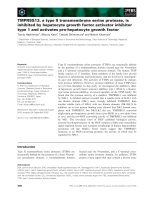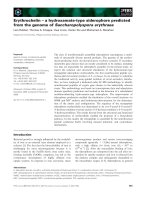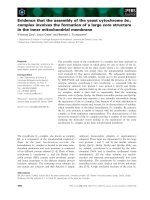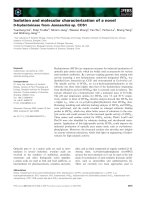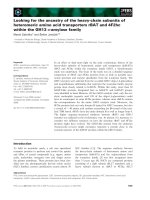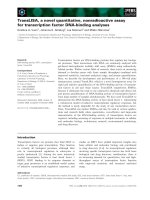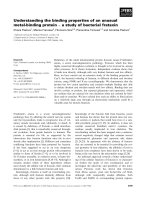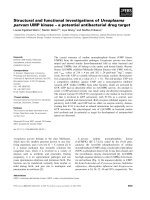Tài liệu Báo cáo khoa học: ""Lexifanis" A Lexical Analyzer of Modern Greek" pdf
Bạn đang xem bản rút gọn của tài liệu. Xem và tải ngay bản đầy đủ của tài liệu tại đây (335.23 KB, 5 trang )
" L e x i f a n i s "
A Lexical Analyzer of Modern Greek
Yannis Kotsanis - Yanis Maestros
Computer Sc. Dpt. - National Tech. University
Heroon Polytechniou 9
GR - 157 73 - Athens, Greece
'l' ~criture fait du savoir une f~te' R.BARTHES
ABST~
Lexifanis" is a Software Tool designed
and implemented by the authors to analyze
Modern Greek Language (~AnuoTL~'). This
system assigns grammatical ~lasses (parts
of speech) to 95-98% of the words of a
text which is read and normalized by the
computer.
By providing the system with the
appropriate grammatical knowledge ( i.e.:
dictionaries of non-inflected words~
affixation morphology and limited surface
syntax rules ) any "variant" of Modern
Greek Language (dialect or idiom) can be
processed.
In designing the system, special con-
sideration is given to the Greek Language
morphological characteristics, primarily
to the inflection and the accentuation.
In Linguistics, Lexifanis, can assist
the generation of indexes or lemmata;
on the other hand readability or style
analysis can be performed using this
software as a basic component. In Word
Processing this software may serve as
a background to build dictionaries for
a spelling checking and error detection
package.
Through this study our research group
has set the basis in designing an
expert system " which is intended to
"understand" and process Modern Greek
texts. Lexifanis is the first working
tool for Modern Greek Language.
"
~AeEL~,i~n~ ~ : Who Brings the Words
to Light. Name given by Lucian (circa
16@ A.C.) to one of his dialogues.
PROLOGUE
In Linguistics the systematic identi-
fication of the word classes rises seve-
ral questions in regard to the morphemic
analysis. In Computational Linguistics
several research areas use fundamental
information such as the "word class"
of
a given wordy isolated or in its context.
In Computer Science the automatic
processing of Greek texts is based on
relevant knowledge, at the lexical level.
In an effort to present a software
tool intended to identify the grammati-
cal classes of the words we have de-
signed and implemented Le×ifanis. We
have used modern greek texts as a test-
bed of our system, but Lexifanis, can
process any "variant" of modern greek,
and even ancient greek language, provided
that it is appropriately initialized.
In this paper s whenever we use the
term greek or greek language we refer to
the modern greek language (~AnuoTL}::~')
in its recent monotonic version (i.e. a
single accent is used, instead of three,
and there are no breathings ~n~'¢O~,=T,=')
WORD
CLASSES
We have found that morphological analy-
sis
of
the greek words can provide ade-
quate
information for the word class
assignment. The majority of the words
in a text can De assigned a unique
( single class >. However, there exist
some words that may be assigned two "pos-
sible" classes. This ambiguity is
inherent to their morphology. On the
other hand we know that consideration of
the words in their context may dis-
ambiguate this classification, if re-
quired.
In this work there is no need
to use any stem dictionary.
154
The ~undamental information used by
Lexifanis to provide the classes of all
greek words is extracted from the affixa-
tion morphology and especially from a
morphemic suffix analysis. In this do-
main, we follow three axes of investi-
gation : the "Accentual Scheme", the
"Ending" and the "Pre ending" of each
word.
Accentual scheme
The "accentual scheme" of
the
word
reflects the position of the stress on
the word; The stress may come only on one
of the last three syllables ( law of the
three syllables ). This scheme is iden-
tified in our system by a code number.
Table 1 lists all possible schemes and
their corresponding identification codes
(IC).
TABLE 1 : "accentual scheme" of
the greek words
accent.
scheme I_~C example
"
+}
@"
: will
:e
I
~a, nw~
: will,that
~e 2 nQ~(;) : what(?)
~ee 3 natO[ : child
~ee 4 xdon : grace
eee 5
~oxa'~>~
: archaic
eee b
out',~T~
: I compose
eee 7 no~6~nu,= : problem
Notation
:
"word start delimiter"
e "syllable"
"accent"
"apostroph"
An example to illustrate the above
feature is the following:
~SL-+O~t-O-OO-t'n
(:justice> IC=&
NOUN
xo~ U.5 ~u-vn (:joyful> IC=7 ADJ
Ending
A detailed suffix analysis of the
highly inflected greek language [KOYP,bT]
[MIRA,59] indicates that there exist mor-
phemes at the end of the word which can
be used to identify the grammatical clas-
ses of the words.
The morphological analysis, presented
in this paper~is based on a right-to-left
scanning of the words. This analysis
identifies word suffixes, named hence-
155
fourth endings. These endings may not
necessarily coincide with the inflectio-
nal suffixes, described in the greek
grammar [TRIA,41]. Consider for example
the following pair of words highlighting
the difference in the ending of the two
words. ( In this example the ending is
the inflexional suffix, as well ).
~xT¢~ - mo - n (: execution) NOUN
mx~ - $o - .~ (: I have executed) ADJ
Notice the identical accentual scheme
of the above two words.
Pre ending
On the other hand, these endings re-
flect the incidental cases of morphemic
ambiguity [KOKT,85] in the inflectional
greek language. This ambiguity can be
resolved if we further penetrate to the
word to identify what we call pre ending.
This pre-ending, in most cases, can be
easily used to disambiguate word
classes and it yields to a unique class
assignment when the ending alone is not
sufficient. Generally, the pre-ending
does not coincide with the derivational
suffix of the word under consideration
[TPIA,41].
Let us now consider the following
example :
xd$' - ate (: you have done>
.9~vaT - ~ (: death, in vocative case~
where,the consideration of the linguistic
inflectional sufi×es -uTz and+m are com-
pletely misleading, as far as the class
assignment is concerned. You may notice
that these two words have the same pre-
ending -,=T In this case a further
morphemic penetration in the word is
required to resolve the ambiguity [KRAU,
81]:
i~v- ,=T - ~ VERB
@,it" - ,~T - m NOUN
The morphemes identified at this last pe-
netration may not necessarily form the
stem of these words. Our system clas-
sifies the first word as a verb and the
second as a noun.
Words in their Context
Finally, if more ambiguities exist in
word class assignment, a consideration of
the "words in their context" may be added
to the affixa~ion morphology. This clas-
sification technique is fruitful in
poorely inflectional languages, such as
English [CHER,8~], [KRAU,81], [ROBI,82].
This syntax analysis is recommended
when the tas~ is to determine the classes
of the words in a ~hole text, as op-
posed to the class assignment to isola-
ted words. By this analysis we gain in-
formation from up to two words that pre-
cede or follow the word under classifica-
tion [TZAP,53]. The following is a clas-
sic disambiguation example :
ol ~vT~¢o - ¢~ <: the contrasts) NOUN
~ ~vT~o - ¢~ <: to contrast) VERB
IMPLEMENTATION
Dictionaries
of
N~n lnfle~t~d Words
Greek language is highly inflected.
However, due to the fact that one out of
two words of a text is a non-inflected
word we have constructed the dictionaries
o~ non-inflected words containing about
4~ entries. In these dictionaries we
accommodated all the non inflected words,
that have no derivational suffix, of mo-
dern greek, such as particles, pronouns,
prepositions, conjunctions, homonyms,etc.
and the inflected articles.
Each word that enters Lexifanis is
first searched in these dictionaries.
If there exist an identical entry, its
class is assigned to this word. Fig. i
lists some of the entries of these di-
ctionaries. As an example consider
"o~o"
(:to the, it). This word can be either
"article
with preposion"
or "pronoun".
art :
art_pron :
art.prep :
art,prep_pron :
prep_pron
:
pron
:
prep :
conj
:
homonym :
particle :
num:
adv :
n
O Ot TWV
Tn T~R TOU
,~Tn~ ~TOU ~TWV
OTn ~TO ~TQ
Uou
~uq
eu~vu
~aL a~
~50o ;Suo TO¢~q
noO ~¢~a x~¢q
Fig. I Part of the Dictionaries
of Non-lnflected Words
Morpholoqical Analysis
The Morphological Analysis is perfor-
med using about 250 rules. The user may
add, delete or modify anyone of these
rules. These rules contain all the in-
formation relevant to the endings and
pre-endings. During this phase, the in-
flected words, mainly verbs and nouns,
are identified. Efficient search is
carried out using the accentual code,
mentioned above.
EXAMPLE: "Five" Morphological Rules :
<leZ/eE>
<n/nq> : noun
"-:eE>
<~l~ql¢> : verb
,~¢~16~1,5p~.=:: :-
<u.'~/~>
:
name
,: dU,~;' > .::1 al,:q / m~ >'- :
noun
<auo~ >
<:1 Q;.' ).
: noun
Notation
e
"word start delimiter"
"syl lable"
"accent"
"ex I usi ve
or"
Li mi
ted
Syntax Anal ysi s
When we want to analyze and classify
the words of a text as a whole, Lexifanis
examines the word under consideration in
its context. This can be accomplished by
invoking the nearly 25 Limited Surface
Syntax Rules.
This step is recommended, in case
a word, is assigned two possible classes
<double class assignment), see Table 2,
using only the affixation morphology.
This double class assignment is due to
the ambiguity inherent to the morpho-
logy of the word.
EXAMPLE: "Two" of the limited surface
syntax rules :
<prep_pron> <verb>
=>
<pron>
.::]verb>
<prep_pron > <art_pron > <uncl ass>
=>
<prep> <art> <name.>
T~ SOFTWARE SYSTEM
Lexifanis is a set of structured pro-
gramms impl~mented in two versions :
* The BATCH system, assigns classes to
the words of a whole text. This system
performs the limited syntax, mentioned
above, in addition to the morpholog,/.
* The INTERACTIVE system, assigns classes
to isolated words. This system performs
only the morphological analysis.
Structure of Lexifanis
The whole software system is designed
and implemented in MODULES or PHASES, ti~
structure of which is illustrated in the
156
Block Diagram
of
the Figure 2. The de-
scription
of
each module follows.
INITIALIZATION - During this phase two
processes take place :
* the creation
of
the Dictionaries
of
Non-lnflected Words~ and
* the generation
of
the appropriate
Automata required to express the mor-
phological rules and the surface
syntax rules
INPUT AND NORMALIZATION OF THE TEXT- The
interactive version of the software sys-
tem performs only the accentual scheme
process, whereas the batch version per-
forms this process in parallel to the
input and normalization processes. Norma-
lization or Word Recognition is the task
of identifying what constitutes a word in
a stream
of
characters.
SUFFIX ANALYSIS - This is the main
process of our system which is activated
for words not contained in dictionaries.
Finite State Automata [AHO ,79] are used
to represent the morphological rules.
LIMITED SYNTAX ANALYSIS - The relevant
information is represented by automata.
Fig. 3 the two dimentional garden
I: set up
dictionaries sl
of
non-inflected words
g~ate morphological &
limited surface syntax rule
~i
input and n(x'maltze text
identify acc.~hm
of
wordsJ
~earch in dic~ionaries~ m~ fmm~
f
non-inflectedl ~ds) 1
I
" r0.r,o,- ,. ;
Llmorfological) analysi
~perform limit~ )
Lsurface syntax analysis
I rocess & output the
J
results
Fig. 2 Structure of Lexifanis
SEARCH IN DICTIONARIES - All the Non-
Inflected Words, with the same accentual
schemer and word lengthy are grouped
together forming a set of small dictio-
nary-trees, "cultivated in a two dimen-
tional garden", minimizing thus the
search time (Fig.3).
RESULTS - This module is best fitted to
the batch version of our system, but it
can be used in the interactive version~
as well.
TABLE 2 : Results obtained from
a Scientific Text
sinqle classes
after
morph.
analys.
%
after
surface
syntax
%
I. article 5.16 13.53
2. article with prepos. 0.00 1.2@
3. pronoun 5.11 6.42
4. numeral 3.91 3.91
5. preposition 2.96 5.26
6. conjuction b.47 8.22
7. adverb b. 12 6.12
S. particle 0.60 0.70
9. noun 12.73 12.98
I~. proper noun 0.3~ 0.30
11. adjective 7.2T 7.27
12. participle 1.50 1.5@
13. verb 13.18 13.18
&5.31 8e.&e
do~!ble classes
14. art_pronoun 11.78
15. art with prep_pron 1.25
16. preposition_pronoun 2.36
17. non-inflected homonym 2.71
18. name : noun_adject 11.33
19. adject_adverb 2.06
2.16
@.0@
@.05
@.85
!1.33
1.8@
31.48 16.69
unclassified words 3.21 2.71
157
The Results concerning the classifica-
tion of a greek text, are summarized in
TaPle 2.
* A single class is assigned to 80-90%
o+
the words of any text, 8-15% are as-
signed two possible classes (double class
assignment),and the remaining 2-5% o+ the
words, are left unclassified.
* The variation
o+
the above percenta-
ges is due to the difference in style
o+
the texts being processed. A scientific
writing, for example, contain fewer ambi-
guities than a poem.
COMPUTATIONAL DETAILS
Lexi+anis" modules are written in
"Pascal" programming language. This
software runs under NOS operating system
on a Cyber 171 main frame computer. Top-
down design and structured programming
guarantee the portability o+ this pro-
duct.
The system uses about 35 Kilowords of
the Cyber computer memory (60bits/word)
and it requires 12 seconds "compilation
time". The batch version classifies the
words at a rate o+ 110 word classes per
second.
AIMM_IP~TIONS
Lexifanis is a complete software tool
which assigns classes to isolated words
entered by the user or, alternatively, to
all the words of an input text. This sys-
tem can be useful to a variety of appli-
cations, some of which are listed below.
The modularity in its design and imple-
mentation, along with the generality of
the concepts implemented guarantee a pro-
perty to our system : it can be easily
integrated into various software systems.
The most apparent application o+ Lexi-
~anis is, in Lexicography, the generation
of "morpheme-based" dictionaries and the
generation of lemmata.
Lexifanis may serve as a background in
a spelling checking and
error
detection
package , or any "writers aid" software
system.
Finally, Machine Translation woulO be
another major area of application where
Lexifanis may be included, as a module or
process, in an "expert system".
EPILO6~JE
we have presented a software tool,
~hich assigns grammatical classes to
the 95-98% of the words o+ a given text.
This system performs suffix analysis
~o assign classes to all the greek words.
For the first time accentual scheme has
been proved useful in the classification
of
greek words. Moreover, ambiguities
inherent to the suffix morphology
of
greek words can be resolved without any
stem dictionary
REFERENCES
[ KOYP, b7 ] : F. KououoO2n,
A'VT ;, ,.~TO.S.q0Ov
Om~ t x6v
"rn~
N~c:~
E22n'v t
}~c;, Ac~nv,~,
1.96 '
[TZAP,53] : A. TC~OT~avo~, N~o~n~'ti~n
~OvTaEt~, 2 T6Uol, A@~va, 194b/1953
[TPIA,41] : M. A. To~.=VTa~UA3i6n~, N~o-
m3nvlx~ FOqUUaTt~, A~v,~ 194111978
[AHO ,79] : A.Aho, Pattern Matching in
Strings, Symposium on Formal Language
Theory, Santa Barbara, Univ. of
Calli+ornia, Dec. 1979
[CHER,80] : L.L.Cherry, PARTS-A System
+or Assigning Word Classes to English
Text, Computing Science Technical
Report #81, Bell Laboratories, Murray
Hill N3 07974, 1980
[KOKT,85] : Eva Koctova, Towards a New
Type
of
Morphemic Analysis, ACL, 2nd
European Chapter, Geneva, 1985
[KRAU,81] : W.Krause and G.Will~e, Lem-
matizing German Newspaper Texts with
the Aid of an Algorithm, Computers
and the Humanities 15, 1981
CMIRA,59] : A . Mirambel, La Langue
Brecque Moderne - Description et
Analyse, Klincksieck, Paris, 1959
CROBI,S2] : J.J.Robinson, DIAGRAM : A
Grammar for Dialogues, Comm. of the
ACM, Vol.25, No i, 1982
[SOME,SO] : H.L.Somers, Brief Descri-
ption and User Manual, Institut pour
les Etudes S~mantiques et Cognitives,
Working Paper #41, 1980
[TURB,81] : T.
N.
Turba, Checking for
Spelling and Typographical Errors in
Computer-Based Text, F'roceedinqs of
the ACM SIGPLAN-SIGOA on Text Maniou-
lation, Portland - Oregon, 1981
[WINd,83] :
T.
Winograd, Language as a
Cognitive Process, Vol. I : Syntax,
Addison - Wesley, 1983
158

